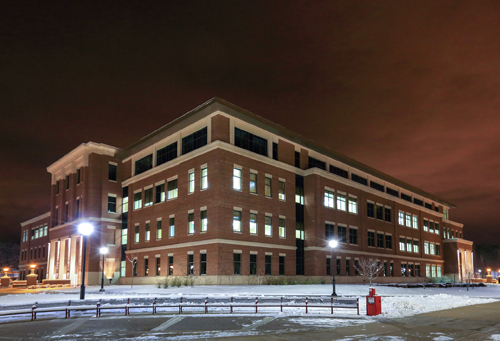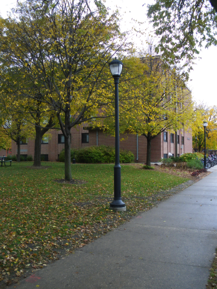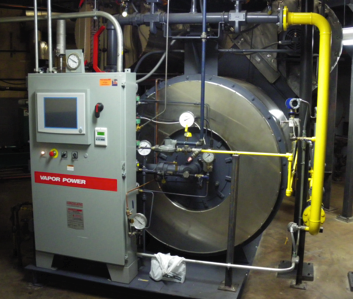Posted 7:12 p.m. Thursday, Jan. 3, 2013

In the last few years, the campus has used nearly 40 percent less water in residence halls and nearly 20 percent less electricity in the Recreational Eagle Center. Learn what more we are doing.
 [/caption]
Achieving sustainability certification for UW-L’s two new building projects is probably the most obvious way the campus is being more environmentally friendly. But UW-L has many more talking points when it comes to being green. In the last few years, the campus has used nearly 40 percent less water in residence halls and nearly 20 percent less electricity in the Recreational Eagle Center.
Evidence of UW-La Crosse’s commitment to sustainability is visible all over campus from energy saving light bulbs and showerheads to more efficient boilers, which heat offices and classrooms.
UW-L’s Department of Facilities Planning and Management projects have generated both environmental and financial savings. And many of these projects are possible because of students’ commitment to sustainability through a special fund set up in spring 2008 for environmental-sustainability projects, the Green Fund. With the help of these student-segregated fees and other on and off-campus partners, the following projects have reduced campus energy requirements.
While walking around campus, consider how this cumulative effect enhances an environmentally sustainable UW-L.
[/caption]
Achieving sustainability certification for UW-L’s two new building projects is probably the most obvious way the campus is being more environmentally friendly. But UW-L has many more talking points when it comes to being green. In the last few years, the campus has used nearly 40 percent less water in residence halls and nearly 20 percent less electricity in the Recreational Eagle Center.
Evidence of UW-La Crosse’s commitment to sustainability is visible all over campus from energy saving light bulbs and showerheads to more efficient boilers, which heat offices and classrooms.
UW-L’s Department of Facilities Planning and Management projects have generated both environmental and financial savings. And many of these projects are possible because of students’ commitment to sustainability through a special fund set up in spring 2008 for environmental-sustainability projects, the Green Fund. With the help of these student-segregated fees and other on and off-campus partners, the following projects have reduced campus energy requirements.
While walking around campus, consider how this cumulative effect enhances an environmentally sustainable UW-L.
1. When you take a shower on campus …
 Consider how much you’re saving. Water consumption at UW-L has been dramatically decreasing since August 2010 when student’s Green Fund dollars were directed toward installing lower flow showerheads in all residence halls. All halls were fitted with the new showerheads except the newest halls, Reuter and Eagle, which already had or included plans for low flow appliances.
Water consumption was reduced by 26 percent in fiscal year 2011 and by 38 percent — 11.1 million gallons — in fiscal year 2012. The baseline for comparison was the average water consumption from fiscal years 2008-2010. At a cost of about $10,000, this lower flow showerhead project is estimated to save about $140,000 a year and lower CO2 emissions by about 1.4 million pounds per year.
Consider how much you’re saving. Water consumption at UW-L has been dramatically decreasing since August 2010 when student’s Green Fund dollars were directed toward installing lower flow showerheads in all residence halls. All halls were fitted with the new showerheads except the newest halls, Reuter and Eagle, which already had or included plans for low flow appliances.
Water consumption was reduced by 26 percent in fiscal year 2011 and by 38 percent — 11.1 million gallons — in fiscal year 2012. The baseline for comparison was the average water consumption from fiscal years 2008-2010. At a cost of about $10,000, this lower flow showerhead project is estimated to save about $140,000 a year and lower CO2 emissions by about 1.4 million pounds per year.
2. When you enter the REC …
Think about the bright future of this building. Replacement of all the lights in the Recreational Eagle Center in March 2011 has reduced electrical consumption by an average 18 percent through August 2012. At a cost of approximately $150,000, this project is estimated to save approximately $21,000 per year and lower CO2 emissions by approximately 400,000 pounds per year. About $101,000 was awarded from the Green Fund for this project. Wisconsin’s Focus on Energy contributed approximately $24,200 with the balance coming from REC.3. When you walk down campus sidewalks …
 Notice your outdoor surroundings are lit with LED light fixtures. During the summer of 2012, new exterior lampposts were installed south of Badger Street. This two-year project will be completed next summer north of Badger Street. The LED lights are estimated to be approximately 30 percent more electrically efficient. And the lighting is designed to reduce light pollution.
Notice your outdoor surroundings are lit with LED light fixtures. During the summer of 2012, new exterior lampposts were installed south of Badger Street. This two-year project will be completed next summer north of Badger Street. The LED lights are estimated to be approximately 30 percent more electrically efficient. And the lighting is designed to reduce light pollution.
4. When you work out or play sports in Mitchell Hall …
Look up. Lighting projects in the Mitchell Hall gym last summer and the field house this summer replaced all HID lights with more energy efficient high-bay fluorescent lighting. Not only that, the projects improved lighting control and light levels required for NCAA competitions. The lighting is designed to be approximately 20 percent more electrically efficient.5. When you turn on a light in a residence hall …
Consider how much more energy efficient the bulb is. All the 32-watt bulbs were replaced with 25-watt fluorescent lamps in all residence halls in June and July 2011 with Green Fund dollars. This project was estimated to reduce electrical consumption in the operating fixtures by 20 percent. At a cost of about $14,000, this project is estimated to save approximately $11,000 a year and lower electrical consumption by about 150,000 kilowatt hours per year within Residence Life. As time and resources permit, this project is being emulated in academic buildings.6. When you’re keeping warm this winter …
 Be thankful for two, new natural gas boilers. In spring 2012, UW-L’s Facilities Planning and Management completed installation of two, high efficiency 20 million BTU/Hr natural gas boilers in the Heating Plant. This project replaced a 25 million BTU/Hr natural gas boiler installed in 1971. Boiler efficiency is estimated to increase by approximately 30 percent. These boilers create steam used to heat the majority of campus buildings, provide hot water and fill other operational needs for steam in non-facilities operations.
Be thankful for two, new natural gas boilers. In spring 2012, UW-L’s Facilities Planning and Management completed installation of two, high efficiency 20 million BTU/Hr natural gas boilers in the Heating Plant. This project replaced a 25 million BTU/Hr natural gas boiler installed in 1971. Boiler efficiency is estimated to increase by approximately 30 percent. These boilers create steam used to heat the majority of campus buildings, provide hot water and fill other operational needs for steam in non-facilities operations.
